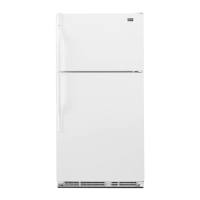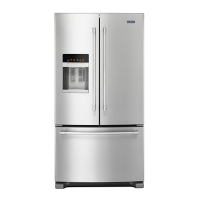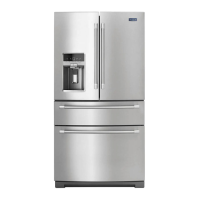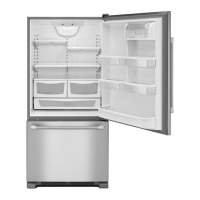Ice Service .............................................................
Ice Cube Trays • The initial batch may also contain impurities from the
new water supply piping. Therefore, all cubes from the
Some models are equipped with ice cube trays and an first two or three batches should be discarded.
ice storage bin. To release the ice cubes from a tray, hold
• When the ice cubes are ejected it is normal for several
the tray upside down over the bin and twist both ends.
cubes to be joined together at the ends. They can easi-
Depending on the model you have chosen, the ice bin ly be broken apart. The ice maker will continue to
either slides into rails under an ice cube tray rack or make ice until the supply of ice cubes raises the wire
stacks neatly on top of the ice cube trays, lever ann, shutting the ice maker off.
• Certain sounds may accompany the various cycles of
the ice maker. The motor may have a slight hum, the
Automatic Ice Maker (optional) cubes will rattle as they fall into an empty storage pan
and the water valve may click or "buzz" occasionally.
Some models are automatic ice maker ready. The number
of the appropriate ice maker kit needed for installation into • If the ice is not used frequently, the ice cubes will
these models appears on the data plate (see page 1). The become cloudy, shrink, stick together and taste stale.
kit contains installation instructions and water connection Empty the ice storage bin periodically and wash it in
lukewarm water. Be sure to dry the bin before replac-
instructions, ing it.
Other models have a factory installed icemaker. The water • To remove the ice bin, pull it forward, away from the
inlet tubing assembly required to complete the water con- ice maker. To avoid the ice maker dumping ice while
nection to the water valve is located in a bag inside the the bin is removed, turn the ice maker offby lifting the
refrigerator. Connect the ice maker to the water supply as wire lever.
instructed in the separate instructions furnished with the
• To replace the ice bin, reverse the above procedure.
refrigerator. Turn the ice maker on by lowering the wire lever arm.
• Beverage and[hods should not be placed in the ice stor-
age bin for quick chilling. These items can block the
wire lever arm, causing the ice maker to malfunction.
• Turn off (arm up) the ice maker when the water supply
is to be shut off for several hours.
For Your Safety
Do not place fingers or hands on the automatic ice
making mechanism while the refrigerator is plugged
in. This will help protect yon from possible inju .ry.It
will also prevent interference with moving parts of the
ejector mechanism and the heating element that
releases the cubes.
Under certain rare circumstances, ice cubes may be
discolored, usually appearing with a green-bluish hue.
The cause of this unusual discoloration can be a com-
bination of factors such as certain characteristics of
local waters, household plumbing and the aceumula-
• After your refrigerator has been hooked up to the water tion of copper salts in an inactive water supply line
supply, move the wire lever arm into the down position, which feeds the ice maker.
This will start its operation. The ice maker will fill with Continued consumption of snch discolored ice cubes
water when the freezer reaches the proper temperature, may be injurious to health. If such discoloration is
• It may be 8 to 12 hours before the ice maker furnishes observed, discard the ice cubes and contact your deal-
any usable ice cubes. The first one or two batches will er to purchase and install a water line filter.
probably contain undersized and irregular cubes
because of air in the supply line.
10

